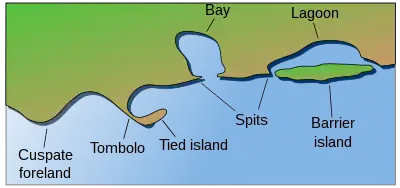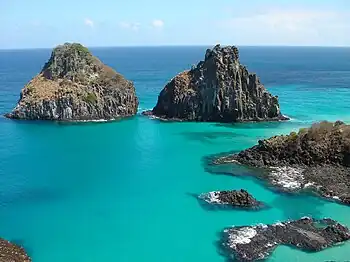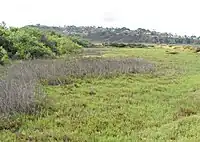
Brackish marshes develop from salt marshes where a significant freshwater influx dilutes the seawater to brackish levels of salinity. This commonly happens upstream from salt marshes by estuaries of coastal rivers or near the mouths of coastal rivers with heavy freshwater discharges in the conditions of low tidal ranges.[1]
Characteristics
The salinity levels in brackish marshes can range from 0.5 ppt to 35 ppt.[2] Marshes are also characterised by low-growing vegetation and bare mud or sand flats.[3] Due to the variations in salinity, brackish marshes create a distinctive ecosystem where plants from either freshwater or saltwater marshes can co-inhabit.[4] The salinity levels also change with the tides, decreasing at low tide and increasing at high tide as ocean water feeds farther upriver.[5]
Ecosystem Services
Biodiversity
In terms of biodiversity, a brackish marsh serves a unique ecological niche.[8] Its vegetation is a byproduct of its salinity levels. High salinity serves as an evolutionary barrier for most plants, creating a less diverse number of plant species as an ecosystem moves from fresh to saltwater. Thus, there are only a few colonies of saltwater native plants in freshwater and almost no freshwater plants in saltwater ecosystems.[4] However, in brackish marshes both types of plants are prevalent and are in fact high in plant productivity.[4] Examples include, arrow arum (Peltandra virginica), soft rush (Juncus effusus), cattail (Typha), and sawgrass (Cladium).[2]
These plants are usually halophytic in order to survive these conditions.[9] For example brackish sites in Georgia, U.S., are dominated by species such as smooth cord grass (Sporobolus alterniflora), big cordgrass (Spartina cynosuroides), and black rush (Juncus roemerianus).[4] Other communities are cabbage palm (Sabal palmetto), sand cordgrass (Spartina bakeri), black rush (Juncus roemerianus), saltgrass (Distichlis spicata, Paspalum distichum), and mixed halophytes (Batis maritima, Salicomia virginica).[10] Along with salinity, brackish marshes face high physical stress due to flooding and wave currents creating adaptive traits within the plant community.[11]
These plant communities also create an environment that provides a nursery for juvenile fish, crustaceans,[12] and birds.[13] Fauna use the shallow habitat and the turbidity of the water to protect themselves from predators. Similarly the surface of the marsh is covered with vegetation which is used by the nekton species for shelter, leaving enough space to move underneath between the stems.[14]
The trophic levels within a brackish marsh has been shown to depend on the amount of macro organic matter in the upper level of soil. This macro organic matter is believed to be the food source of detritivore benthic animals that support higher trophic levels. These materials build up as the marsh matures, making age another factor in the biodiversity of a brackish marsh.[14]
Algae also make up a large part of the biodiversity in brackish marshes. The most common algae, diatoms, make up a large portion of the algal community in brackish marshes.[15] Diatoms are eukaryotic microorganisms that have a cell wall that is composed of silica and can exists in freshwater or marine environments making them good candidates for brackish marshes.[15] These diatoms can be either planktic, which float freely in the water column, or benthic, which attach to a substrate.[15] Some examples of diatoms that can be found in brackish marshes are from the genera (Navicula), (Nitzschia), (Diploneis), (Cyclotella), (Cymbella), (Fragilaria), (Gyrosigma), (Tabularia), (Amphora), (Cocconeis), and many more.[16] Many different organisms in these brackish marshes depend on diatoms as a food source so they are ecologically important. Some examples of organisms that feed on diatoms are bivalves,[17] mollusks,[18] fish,[18] copepods,[18] decapod larvae,[18] and ducks,[19] as well as many others. Many organisms in these brackish marshes consume diatoms so they are very valuable to maintaining balance in these types of ecosystems.
Another group of algae that is present in brackish marshes are fucoid algae.[20] This is a type of brown macroalgae in the class Phaeophyceae.[20] Brown algae are eukaryotic stramenopiles which means that they are at one point flagellated and most people know them as seaweeds in coastal areas.[21] Examples of brown algae that have been found in brackish marshes are Fucus vesiculosus , Ascophyllum nodosum, [20] the genus Sphacelaria, [22] and many others.
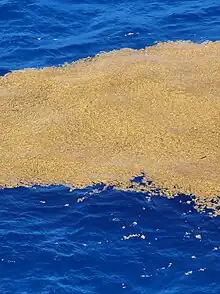
Yellow-green algae can also be found in brackish marshes. Yellow-green algae are eukaryotic algae in the class Xanthophyceae.[23] An example of this is Vaucheria. [22]
Green algae can also be found in brackish marshes. Some examples of the different genera of green algae that can be found in brackish marshes are Enteromorpha, Ulothrix, Rhizoclonium, Blidingia, Percursaria, and many others. [22]
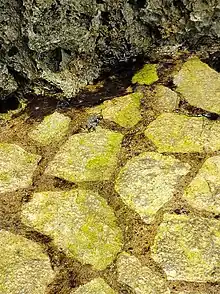
Typically, sedges and grasses dominate the vegetation in brackish marshes. Plants in brackish marshes are salinity tolerant and they tolerate frequent flooding.[24] They also have frequent tidal waves disturbing the area as well as seasonal hurricanes and tropical storms. (Julia bass) According to (Makenzie) plants in coastal marshes resist salinity by refraining from the uptake of salt via their root system. Some examples of plants that grow in brackish marshes are Panicum hemitomon, Spartina patens, Zostera japonica, Haloxylon recurvum, Juncus roemerianus, Borrichia frutescens,[24] Schoenoplectus americanus, Distichlis spicata and many others. [25]
Human use and impacts
Brackish marshes are very important for flood control.[11] However, they are often subject to heavy pollution and habitat degradation from land reclamation.[12] For example, the Indian River Lagoon has suffered significant man-made changes since the 1940s. Marshes were often dredged or impounded to prevent mosquitoes, however this led to the disruption of connectivity by replacing marshes with open water. These changes prevented fires that allowed invasive species to move into the remaining marshes.[10]
Brackish marsh environments are especially susceptible to human degradation; they are ideal areas for land conversion and development because they aren’t rocky and tend to be located in temperate coastal regions. Brackish marshes are areas that can provide connections for both land and water access.[6]
There are many ways humans have disrupted and degraded brackish marshes. When humans divert water from these marshes it leads to land sinking, also known as subsidence. Humans have also modified the vegetation of brackish marshes to change water and sediment flow. Brackish marshes have been subjected to an overabundance of nutrients and pollutants from industrial and urban sources. Environmental stressors from human impact have changed brackish marsh biodiversity to mainly stress-tolerant invasive grasses. Additionally, negative consequences of climate change, such as sea level rise, will likely begin to harm brackish marsh ecosystems.[6][7]
Brackish marshes can be restored by human intervention. Studies have found that given that restoration is properly carried out, fish do not discriminate between restored or natural marshes.[14]
Conservation and threats
As in most habitats, the greatest threat towards brackish marshes are humans. Traditionally, direct human activities such as dredging and development are the main cause of destruction. Pollution has also been a threat to brackish marshes through chemical run-off.[5] Once degraded, it could take at least 30 to 90 years for restored marsh soil to become equivalent to a natural marsh in terms of nitrogen and organic carbon profile. In some cases, these process could take over 200 years to achieve the wetland soil characteristics of certain communities.[26]
For conservation, the key is to restrict human activities. Installing a passive management system could help restore certain species using brackish marshes' role as an ecological nursery.[27] For some areas, periodic livestock grazing could help create a better habitat for certain species of birds.[13] Brackish marshes are a unique type of wetland and the local circumstances are paramount to consider for either conservation, biodiversity, or restoration.
Brackish marshes are also great in reducing nutrient pollution such as nitrogen.[28] There are many sources of nitrogen entering the water systems especially in Texas. In Texas there are many dairy farms as well as ranch land and farm land. All these are sources of nitrogen in the Texas water systems. Having large amounts of nitrogen in a water system can cause eutrophication, harmful algal blooms, and fish kills.[28] In wetlands, nitrogen is used by the vascular and non-vascular vegetation to grow, therefore removing the nitrogen naturally and preventing a large amount of nitrogen from entering the coastal region creating anoxic habitats in the ocean.[28] Conservation of the brackish marsh wetlands can be a last resort to help prevent these potential problems.
References
- ↑ Field Guide to Coastal Wetland Plants of the Southeastern United States, Ralph W. Tiner, p. 15
- 1 2 "Freshwater vs. Saltwater Wetlands in North Carolina" (PDF). Archived (PDF) from the original on 2021-04-17.
- ↑ Vernberg, F. John (1993). "Salt-marsh processes: A Review". Environmental Toxicology and Chemistry. 12 (12): 2167–2195. doi:10.1002/etc.5620121203. ISSN 1552-8618.
- 1 2 3 4 Więski, Kazimierz; Guo, Hongyu; Craft, Christopher B.; Pennings, Steven C. (2010-01-01). "Ecosystem Functions of Tidal Fresh, Brackish, and Salt Marshes on the Georgia Coast". Estuaries and Coasts. 33 (1): 161–169. doi:10.1007/s12237-009-9230-4. ISSN 1559-2731. S2CID 2199915.
- 1 2 "Brackish Tidal Marsh Guide - New York Natural Heritage Program". guides.nynhp.org. Retrieved 2021-04-17.
- 1 2 3 4 5 6 7 Gedan, K. Bromberg; Silliman, B.R.; Bertness, M.D. (2009-01-01). "Centuries of Human-Driven Change in Salt Marsh Ecosystems". Annual Review of Marine Science. 1 (1): 117–141. doi:10.1146/annurev.marine.010908.163930. ISSN 1941-1405. PMID 21141032.
- 1 2 Coverdale, Tyler C.; Brisson, Caitlin P.; Young, Eric W.; Yin, Stephanie F.; Donnelly, Jeffrey P.; Bertness, Mark D. (2014-03-27). "Indirect Human Impacts Reverse Centuries of Carbon Sequestration and Salt Marsh Accretion". PLOS ONE. 9 (3): e93296. doi:10.1371/journal.pone.0093296. ISSN 1932-6203. PMC 3968132. PMID 24675669.
- ↑ Cognetti, Giuseppe; Maltagliati, Ferruccio (2000-01-01). "Biodiversity and Adaptive Mechanisms in Brackish Water Fauna". Marine Pollution Bulletin. 40 (1): 7–14. doi:10.1016/S0025-326X(99)00173-3. ISSN 0025-326X.
- ↑ Dijkema, Kees S. (1990-01-01). "Salt and brackish marshes around the Baltic Sea and adjacent parts of the North Sea: Their vegetation and management". Biological Conservation. 51 (3): 191–209. doi:10.1016/0006-3207(90)90151-E. ISSN 0006-3207.
- 1 2 Schmalzer, Paul A. (1995-07-01). "Biodiversity of Saline and Brackish Marshes of the Indian River Lagoon: Historic and Current Patterns". Bulletin of Marine Science. 57 (1): 37–48.
- 1 2 Carus, Jana; Paul, Maike; Schröder, Boris (2016). "Vegetation as self-adaptive coastal protection: Reduction of current velocity and morphologic plasticity of a brackish marsh pioneer". Ecology and Evolution. 6 (6): 1579–1589. doi:10.1002/ece3.1904. ISSN 2045-7758. PMC 4801978. PMID 27087929.
- 1 2 Cattrijsse, A; Makwaia, Es; Dankwa, Hr; Hamerlynck, O; Hemminga, Ma (1994). "Nekton communities of an intertidal creek of a European estuarine brackish marsh" (PDF). Marine Ecology Progress Series. 109: 195–208. Bibcode:1994MEPS..109..195C. doi:10.3354/meps109195. ISSN 0171-8630.
- 1 2 Mandema, Freek S.; Tinbergen, Joost M.; Ens, Bruno J.; Koffijberg, Kees; Dijkema, Kees S.; Bakker, Jan P. (2015-09-01). "Moderate livestock grazing of salt, and brackish marshes benefits breeding birds along the mainland coast of the Wadden Sea". The Wilson Journal of Ornithology. 127 (3): 467–476. doi:10.1676/13-133.1. ISSN 1559-4491. S2CID 83788168.
- 1 2 3 Hampel, H; Cattrijsse, A; Vincx, M (2003-01-01). "Habitat value of a developing estuarine brackish marsh for fish and macrocrustaceans". ICES Journal of Marine Science. 60 (2): 278–289. doi:10.1016/S1054-3139(03)00013-4. ISSN 1054-3139.
- 1 2 3 Pfister, Laurent; McDonnell, Jeffrey J.; Wrede, Sebastian; Hlubikova, Dasa; Matgen, Patrick; Fenicia, Fabrizio; Ector, Luc; Hoffmann, Lucien (August 5, 2009). "The rivers are alive: on the potential for diatoms as a tracer of water source and hydrological connectivity". Hydrological Processes. 23 (19): 2841–2845. doi:10.1002/hyp.7426. S2CID 33508939 – via Wiley online library.
- ↑ Parsons, Michael L.; Dortch, Quay; Turner, R. Eugene; Rabalais, Nancy N. (December 1999). "Salinity History of Coastal Marshes Reconstructed from Diatom Remains". Estuaries. 22 (4): 1078. doi:10.2307/1353085. ISSN 0160-8347. JSTOR 1353085. S2CID 84822337.
- ↑ Davenport, John; Ezgeta-Balić, Daria; Peharda, Melita; Skejić, Sanda; Ninčević-Gladan, Živana; Matijević, Slavica (April 2011). "Size-differential feeding in Pinna nobilis L. (Mollusca: Bivalvia): Exploitation of detritus, phytoplankton and zooplankton". Estuarine, Coastal and Shelf Science. 92 (2): 246–254. doi:10.1016/j.ecss.2010.12.033. ISSN 0272-7714.
- 1 2 3 4 Lebour, Marie V. (October 1922). "The Food of Plankton Organisms". Journal of the Marine Biological Association of the United Kingdom. 12 (4): 644–677. doi:10.1017/S0025315400009681. ISSN 1469-7769. S2CID 53656496.
- ↑ Atkinson, Kathleen M. (1972-11-15). "Birds as transporters of algae". British Phycological Journal. 7 (3): 319–321. doi:10.1080/00071617200650331. ISSN 0007-1617.
- 1 2 3 Tyrrell, Megan C.; Dionne, Michele; Eberhardt, Sarah A. (May 2012). "Salt Marsh Fucoid Algae: Overlooked Ecosystem Engineers of North Temperate Salt Marshes". Estuaries and Coasts. 35 (3): 754–762. doi:10.1007/s12237-011-9472-9. ISSN 1559-2723. S2CID 86377945.
- ↑ Cock, J. Mark; Peters, Akira F.; Coelho, Susana M. (August 2011). "Brown algae". Current Biology. 21 (15): R573–R575. doi:10.1016/j.cub.2011.05.006. ISSN 0960-9822. PMID 21820616. S2CID 9779828.
- 1 2 3 Nienhuis, P. H. (1987), Huiskes, A. H. L.; Blom, C. W. P. M.; Rozema, J. (eds.), "Ecology of salt-marsh algae in the Netherlands: A Review", Vegetation between land and sea, Dordrecht: Springer Netherlands, pp. 66–85, doi:10.1007/978-94-009-4065-9_6, ISBN 978-94-010-8305-8, retrieved 2023-03-02
- ↑ Gallagher, Susan B. (1981). "Vaucheria (Xanthophyceae, Vaucheriaceae) of the Central Florida Gulf Coast". Bulletin of Marine Science. 31 (1): 184–190 – via Ingenta.
- 1 2 Jenkins, Mackenzie L.; Schafer, Jennifer L. (2022). "Salt Marsh Plant Community Structure on Horse Island, South Carolina". Journal of the South Carolina Academy of Science. 20 (2): 9–12 – via Academic Search Complete.
- ↑ Gabriel, Jared R.; Reid, Jessica; Wang, Le; Mozdzer, Thomas J.; Whigham, Dennis F.; Megonigal, J. Patrick; Langley, J. Adam (September 2022). "Interspecific Competition is Prevalent and Stabilizes Plant Production in a Brackish Marsh Facing Sea Level Rise". Estuaries and Coasts. 45 (6): 1646–1655. doi:10.1007/s12237-021-01043-9. ISSN 1559-2723. S2CID 245856791.
- ↑ Craft, Christopher; Broome, Stephen; Campbell, Carlton (2002). "Fifteen Years of Vegetation and Soil Development after Brackish-Water Marsh Creation". Restoration Ecology. 10 (2): 248–258. doi:10.1046/j.1526-100X.2002.01020.x. ISSN 1526-100X. S2CID 55198244.
- ↑ Agha, Mickey; Yackulic, Charles B.; Riley, Melissa K.; Peterson, Blair; Todd, Brian D. (2020-10-01). "Brackish Tidal Marsh Management and the Ecology of a Declining Freshwater Turtle". Environmental Management. 66 (4): 644–653. doi:10.1007/s00267-020-01326-0. ISSN 1432-1009. PMID 32651626. S2CID 220462500.
- 1 2 3 Cheng, F. Y.; Van Meter, K. J.; Byrnes, D. K.; Basu, N. B. (December 2020). "Maximizing US nitrate removal through wetland protection and restoration". Nature. 588 (7839): 625–630. doi:10.1038/s41586-020-03042-5. ISSN 1476-4687. PMID 33328640. S2CID 229300707.


